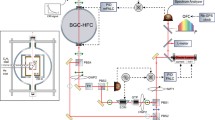Abstract
Based on the theory of molecular vibration relaxation, the model of buffer gas effect was built up. By theoretically deducing the vibrational lower-level deactivation rate of operating gas molecule with quantum mechanics, the selection rules of high-efficient buffer gas under different working conditions were educed and tested by experiments. The results could be helpful to the study of large-power wide-range efficient tunable miniature pulsed optically pumped submillimeter wave laser and its application.
Similar content being viewed by others
Reference
T.Y. Chang and C. Lin, J.Opt.Soc. Am., 1976, Vol.66(4):362
N.M. Lawandy and G.A. Koepf, Opt. Lett., 1980, Vol.5:366
R. Behn et al, J.Appl.Phys., 1983, Vol.54(6):2995
R. Behn et al., IEEE Journal of Quantum Electronics, 1985, Vol.QE-21(8):1278
Xizhang Luo, Ruman Qiu, Optimized Operation of Optically Pumped NH3 laser emission at 12.08 μ m and 12.81 μ m, Int. J. IR-MMW, 1997, Vol.18(1):641-652
Xizhang Luo, Hongjian Li, The Optimum Operation of an Unified Mini-optically pumped NH3 submillimeter wave laser, Int. J. IR-MMW, 1999, Vol.20(2):1085-1090
Li Hongjian, Luo xizhang et.al., Effects of buffer gas on the output of OPFIR NH3 cavity laser, Int. J. IR&MMW, 2000,Vol.21(5)
Zhong Lichen, Ding Hau[shu, Molecular Spectrum and Laser, Publishing House of Electronics Industry, 1987 (the first edition)
D.T. Hodges, et al., Infrared Phys., 1976, Vol.16:662
C.O. Weiss and G. Kramer, Appl. Phys., 1976, Vol.9:175
L.A. Gamss and A.M. Ronn, Chem. Phys., 1975, Vol.9:319
J.M. Manley and H.E. Rowe, Proc. IRE, 1956, Vol.44:904
T. Lehecka et al., IEEE J. Quantum Electron., QE-24, 1988:5
Xizhang Luo, Jiancong Luo et al., Int. J. IR&MMW, 1999, Vol.20(6):1085
R. N. Schwartz, Z. I. Slawsky, K. F. Herzfeld, Calculation of Vibrational Relaxation Time in Gases, J. of Chem. Phys., 1952, Vol.20(10):1591
H. Eyring, S. H. Lin, S.M. Lin, Basic Chemical Kinetics, John Wiley&Sons, 1980
J. O. Hirschfelder, R. B. Bird and E. L. Spotz, J. Chem. Phys. 1948, Vol.16:968
S. Chapman and T. G. Cowling, The Mathematical Theory of Non-uniform Gases (third edition), Cambridge University Press, 1970
Li Hongjian, Study of the Effect of Buffer Gas on Miniature Optically Pumped
Author information
Authors and Affiliations
Rights and permissions
About this article
Cite this article
Xun, Z., Ping, Z., Weibin, C. et al. A Quantum-Mechanical Explanation of Buffer Gas Effect on Submillimeter Wave Laser. International Journal of Infrared and Millimeter Waves 24, 1101–1111 (2003). https://doi.org/10.1023/A:1024708816455
Issue Date:
DOI: https://doi.org/10.1023/A:1024708816455




